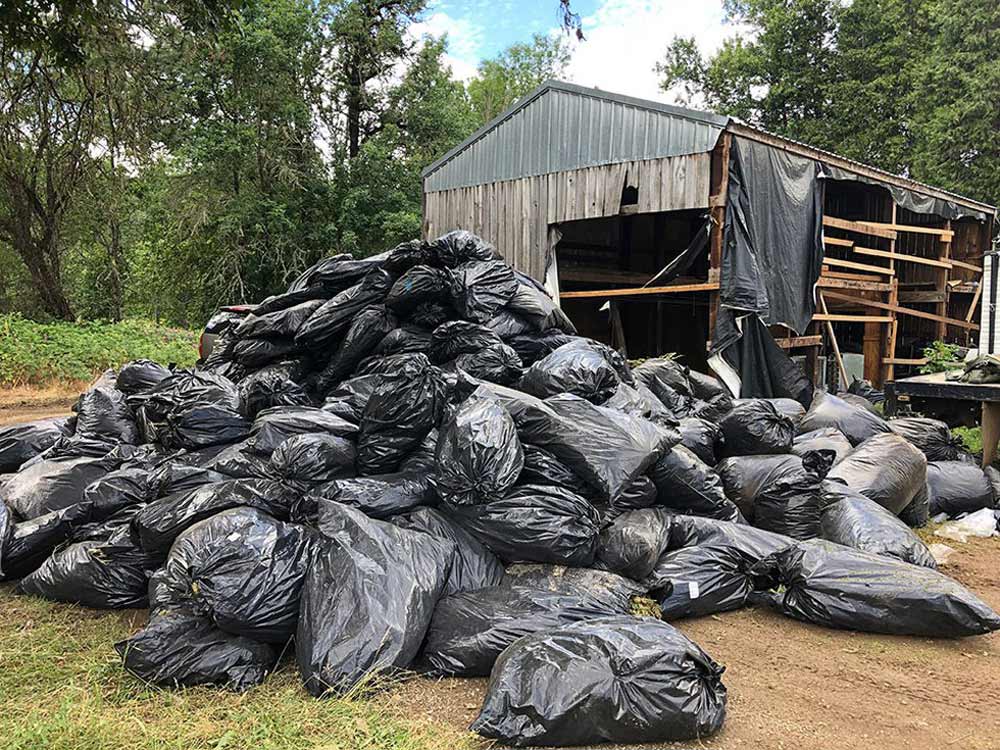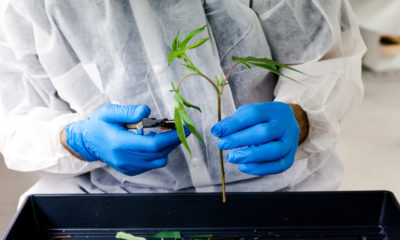
Economics
Oregon’s Illicit Cannabis Market is Booming
Industrial-scale illicit cannabis grow operations keep being raided by police in Oregon. So, why does the state’s illicit cannabis market continue to be lucrative?
When Oregonians voted to legalize cannabis in 2014, there were high hopes for a thriving legal industry in the Beaver State—and an end to big police raids on growers. Over the past three years, however, a market glut has driven prices down in the legal sector. At the same time, law enforcement has repeatedly carried out raids on impressively large illicit operations—especially in the south of the state. What explains this illicit cannabis market paradox?
Huge Illicit Operations
An overview of some recent raids in Southern Oregon—especially the adjacent counties of Josephine, Jackson and Klamath—quickly makes clear the scope of the situation.
On July 6, the Josephine Marijuana Enforcement Team (JMET) served search warrants at two properties in Wolf Creek, uncovering some 14,000 cannabis plants in multiple greenhouses and indoor grow facilities. The JMET said detectives also found about 7,000 pounds of processed marijuana. Two people, identified as Chen Fengzhi and Liang Shao, were arrested.

On June 23, the JMET joined with the Oregon State Police Drug Enforcement Section to execute a search warrant in Cave Junction, confiscating 3,944 plants in seven “industrial-sized” greenhouses.
On June 22, the JMET raided a property in Grants Pass, seizing 700 plants and 2,500 pounds of processed marijuana, as well as a pound-and-a-half of methamphetamine and multiple firearms. A man identified as Tung Ming Chen was arrested.
On June 8, the JMET and Rogue Area Drug Enforcement (RADE) team searched properties outside Selma, finding some 22,000 plants in 34 greenhouses. One man, Juan Valdovinos Tafolla, was arrested, and several others “temporarily detained for officer safety,” the Sheriff’s Office said. In addition to marijuana offenses, Valdovinos Tafolla was slapped with charges of “appropriation of water,” for allegedly using a pump to divert water from a nearby creek.
Last harvest season saw a spate of impressively big raids.
On Nov. 18, the Oregon State Police seized an estimated 500,000 pounds of processed marijuana in Jackson County’s White City. More than 100 people were temporarily detained. Many were migrant workers living on site in “subpar living conditions without running water.”
On Sept. 14, the Basin Interagency Narcotics Enforcement Team (BINET) in Klamath County raided a large marijuana grow operation near the town of Bonanza, reportedly destroying more than 50,000 plants.
State of Emergency in Jackson County
Jackson County actually declared a “state of emergency” on Oct. 1, with commissioners formally calling on Gov. Kate Brown to deploy the National Guard to help shut down illegal cannabis market’s grow operations.
The Board of Commissioners said local law enforcement was overwhelmed and warned of an “imminent threat to the public health and safety of our citizens from the illegal production of cannabis in our county.”
The Oregon Legislature held hearings on the question Nov. 16, taking testimony from law enforcement and licensed cannabis growers alike. Jackson County Sheriff Nathan Sickler attributed a local spike in violent crime to the profusion of illegal grow operations.
“We’ve had stabbings, robberies, thefts, burglaries, homicides, sex crimes, motor vehicle accidents, DUIs, all related to the influx of the marijuana-cannabis industry in our in our valley,” Sickler said. “It’s certainly an issue we deal with on a daily basis here.”
Local authorities especially stressed illegal water use by outlaw growers—a particularly pressing concern amid a megadrought across the Western states.
A study on the question by the Cannabis Research Center at the University of California, Berkeley, found: “Because peak water demand for cannabis occurs in the dry season, when streamflow is at its lowest levels, even small diversions can dry streams and harm aquatic plants and animals.”
The Oregon Water Resources Department has only four full-time employees to handle complaints in Jackson and Josephine counties, and their workload is rapidly backing up.
Cartel Involvement, Maybe
Media and law enforcement are increasingly raising fears up of a heavy presence of organized crime and even foreign drug cartels in Oregon’s illicit cannabis market.
In January, Politico up ran an in-depth look at the question, finding: “Over the last two years, there’s been such an influx of outlaw farmers that southern Oregon now rivals California’s notorious Emerald Triangle as a national center of illegal weed cultivation.” Jackson County’s Sheriff Sickler was cited as putting the number of illicit grow operations in the region at upwards of 1,000. The Oregon Liquor & Cannabis Commission (OLCC), which oversees the state’s legal industry, places the number of illicit cannabis market grow operations statewide at double that.
The Politico account stressed fears by local law enforcement that international organized crime has targeted the region as a center of outlaw cultivation: “Cartels roll in and offer long-time residents as much as a million dollars in cash for their property, and hoop houses follow soon after the sale is complete. Residents have become accustomed to hearing Bulgarian, Chinese, Russian and Hebrew spoken at the grocery store.”
“Two weeks ago, we took down a Bulgarian operation and in the same week an Argentinian operation,” Josephine County Sheriff Dave Daniel told Politico, adding that his office has also recently dealt with Chinese and Mexican-run operations.
But recent arrests have included seemingly “respectable” executives accused of covering for the illicit cannabis market.
Last October, John A. Magliana III, scion of a prominent Oregon family, pleaded guilty in US District Court in Medford to a felony charge of possession with intent to distribute marijuana, admitting that he managed an unlicensed Selma grow operation that produced for the out-of-state market. Links to a distribution ring in Indiana were claimed.
That same month, the Josephine County Sheriff’s Office arrested a Grants Pass realtor on charges of arranging purchases of property for illegal cultivation. Tyra Polly Ann Foxx of RE/MAX real estate agency is accused of conducting more than two dozen such transactions, converting ownership of properties from individuals to LLCs in order to cover illegal activity.
And, playing right into conservative fears and stereotypes, the OLCC reported in September that some licensed hemp farms in the region are actually producing marijuana. In an audit dubbed “Operation Table Rock” (after a volcanic plateau in the region), the OLCC and the Oregon Department of Agriculture tested plants at 212 registered hemp grows in Jackson and Josephine counties. No less than 54% were found to be growing illegal cannabis. There were another 76 farms that declined to allow inspectors on the property, and a further 23 where inspectors were unable to establish contact.
“I believe from my experience down there, there are more illicit grow operations than there are registered grows,” said Richard Evans, OLCC senior director for licensing and compliance, speaking to local Jefferson Public Radio.
Adjoining these counties on the south is Northern California’s Siskiyou County, where ethnic tensions are rising following similar hype about foreign cartel involvement in cannabis cultivation. Hmong immigrants from Laos have been getting in on the cannabis economy—sparking a xenophobic backlash, and blatantly racially targeted enforcement. This, in turn, has sparked protests by Hmong residents.
This points to the potential for ugliness if the situation in Southern Oregon continues in its dystopian trajectory.
Sweetening the Legal Sector
The Politico account contained one passage that cut to the heart of the dilemma: “Oregon’s weed is some of the cheapest in the nation, and Oregonians predominantly purchase weed from licensed dispensaries. But most of the illicit weed grown in southern Oregon is leaving the state, heading to places where legal weed is still not available for purchase such as New York or Pennsylvania—or where the legal price is still very high, like Chicago and Los Angeles.”
The OLCC has taken some steps to lift the regulatory burden on the legal sector, which could help make it more competitive. Late last year, the agency promulgated changes that double both the purchasing limit on cannabis flower and the THC maximum for edibles and extracts. As of Jan. 1, customers may buy two ounces of weed at a time—up from one ounce. As of April 1, THC limits for edibles increased from 50 to 100 milligrams per package, and that for extracts from 1,000 to 2,000 milligrams per package.
Very significantly, home delivery is now permitted across municipal and county lines—with the approval of local authorities. Previously, dispensaries were limited to deliveries within the locality where the retailer was located.
But whether these welcome measures are sufficient to meet the enormity of the illicit cannabis market problem is dubious at best. Industry advocates have been pressing for a legal interstate market to relieve the glut in Oregon’s licensed sector. As long as licensed producers are confined to an in-state market, it’s hard to see how they can compete with illicit producers bound by no such restrictions.
This points to the necessity of a national market in order for legalization to really be effective at bringing cannabis in from the cold. Proposals have been floated even by state governors for a “common market” among states that have legalized. Whether the federal government will acquiesce in this, of course, is the big question.























